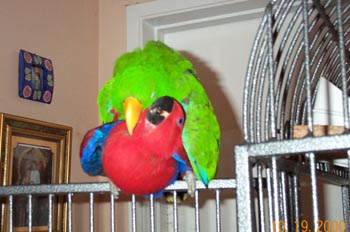Eclectus Parrot - Solomon
Solomon Island Eclectus Parrot Scientific Name: Eclectus roratus solomonensis
Mon, 14th July, 2025 - 8:38 pm GMT
Sponsor Ads:

Alternative Name
Solomon Island Eclectus Parrot Scientific Name: Eclectus roratus solomonensisBasic Info
Averaging between 12 and 13 inches in length at maturity, the Solomon Eclectus Parrot is one of the two smallest subspecies of Eclectus Parrots. The feathering of the Eclectus Parrot has a strange texture, and has been described as "hair-like". Male Solomon Eclectus Parrots have yellow-tinted green feathering over the majority of their bodies. Their primary wing coverts and primary flight feathers are a dark blue color, edged in green. The upper side of the Solomon Eclectus male's tail is green and the tips of the feathers have yellow edging. The underside of the tail is black, edged with a thin band of pale yellow stretching for about ten millimeters. The iris is a reddish orange color. Female Solomon Eclectus Parrots have stunning red plumage with dark blue under-wing coverts. They also have a band running to the nape that is dark blue. Females have dark blue, green-edged primary coverts and primary flight feathers like the male, as well. The tips of their red tails have pale edging, and their irises are a light yellow-white color.
Health
Solomon Eclectus Parrots may be prone to feather plucking. To prevent this, allow the birds plenty of items to chew and try to prevent them from becoming bored. Feather plucking may also be brought on by dietary changes, inappropriate enclosure size, stress, bullying, or climatic changes. Eclectus Parrots have a longer digestive tract than any other parrot, and they need more fresh veggies and fruits than most parrots. Breeding The Solomon Eclectus Parrot is bred commonly in captivity. Generally, Solomon Eclectus Parrots breed year round. They reach sexual maturity between two and three years of age. When she is about to breed, the female Eclectus may become quite aggressive, even toward her handler. Before laying, the female will generally spend a lot of time fussing in her nest box to arrange it suitably. She will usually lay two eggs. Because female Solomon Eclectus Parrots will often sit on their eggs awkwardly or forcefully and accidentally break them, a slanted or L shaped nesting box is recommended, so the birds have room to position themselves better. The female Solomon Eclectus Parrot will incubate her eggs for about four weeks before they hatch. The fledglings will develop sexually dimorphic coloration by the time they are about 28 days old. Usually, they will leave the nest by 75 days of age.Habitat
N/ABehavior
The incredibly beautiful Solomon Eclectus Parrot has a personality that is as colorful as its feathers. In the wild, Solomon Eclectus Parrots nest high in the forest canopy. In captivity, they tend to do well when kept in pairs. In the wild, a pair will usually be at the top of a group's hierarchy, with other parrots in the group helping the dominant pair to raise their young. Solomon When kept outdoors, a 4.5 by 1.2 by 2 meter aviary in a sheltered area will suffice for a pair. These birds are quite loud, but they can make good pets for people who will tolerate the noise. To reduce the birds' noise level, you may try turning on a radio for them, to allow them some form of audio entertainment other than their own voices. Solomon Eclectus Parrots can be taught to imitate noises and talk quite well. As with all parrots, generally, hand raised birds will make much better, tamer, healthier pets than wild-caught birds.Origin
Solomon IslandsHistory
Solomon Eclectus Parrots are native to Bismarck, the Solomon Islands, and Admiralty Archipelagos. They are not uncommon in their natural habitat and are one of the Eclectus species commonly seen in the pet trade.Common Foods
Eclectus Parrots kept in captivity may be fed plenty of fresh fruits and vegetables along with a good basic pellet diet or seed mix. The majority of the seeds should be soaked to make them softer for the parrots. Plenty of branches or wood should be proviSponsor Ads:
Beauty is only skin deep, but ugly goes right to the bone. -- Unknown
Eclectus Parrot - Solomon
Coded by: BGID® | ALL RIGHTS RESERVED Copyright © 2000-2025
Disclaimer | Privacy | Report Errors / Contact | Credits








 President of the United States of America - Real Estate mogul, Pageant owner and now one of the most controversial men in political history.
President of the United States of America - Real Estate mogul, Pageant owner and now one of the most controversial men in political history.  Global warming has been in and out as the "latest" hot topic for many years. It is, according to modern scientists, the result of man-made industrial pollutants, clearing forested areas, agriculture, etc. But now they are thinking it started way before the Industrial Revolution...
Global warming has been in and out as the "latest" hot topic for many years. It is, according to modern scientists, the result of man-made industrial pollutants, clearing forested areas, agriculture, etc. But now they are thinking it started way before the Industrial Revolution...  Politician, US Vice President and President of the USA - Joseph Robinette Biden Jr.
Politician, US Vice President and President of the USA - Joseph Robinette Biden Jr.  versus
versus  Russia: 'The Evil Empire'? Are they all that bad or is it just the USA trying to portray Russia as bad because they are a world power with land bigger and a society very different from the USA ideal?
Russia: 'The Evil Empire'? Are they all that bad or is it just the USA trying to portray Russia as bad because they are a world power with land bigger and a society very different from the USA ideal? 
 Corona virus
Corona virus 
 Users with wide screen monitors can benefit from more content on every page.
Users with wide screen monitors can benefit from more content on every page.